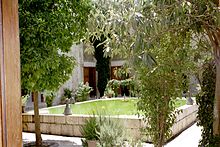- Nur al-Din Bimaristan
-
Nur al-Din Bimaristan (Arabic: البيمارستان النوري) is a large medieval bimaristan ("hospital") in Damascus, Syria. It is located in the al-Hariqa quarter in the old walled city, to the southwest of the Umayyad Mosque.[1] It was built and named after the Zengid Sultan Nur ad-Din in 1154. The bimaristan is well known for its unusual portal, which displays an antique lintel and a curious flattened muqarnas vault. It is also unusual in its full-scale Mesopotamian-style muqarnas vault over the vestibule.[2] It was restored in 1975 and now houses the Museum of Medicine and Science in the Arab World.
Architecture
The building is of the Iraqi type, in plan also, with a symmetrical disposition of four iwans around a central courtyard. But other than that, the building is fully in the Damascene construction tradition, and in fact stones from the outer enclosure of the antique temple were reused in it.[3]
References
- ^ http://www.al-hakawati.net/arabic/Architecture/school3.asp
- ^ Allen, Terry. Classical Revival. p. 57ff.
- ^ Allen, Terry (1999). Ayyubid Architecture. Solipsist Press. ISBN 0-944940-02-1. http://www.sonic.net/~tallen/palmtree/ayyarch/ch2.htm#alep.bimn.
External links
- Nur al-Din Bimaristan, at archnet.org
Coordinates: 33°30′37″N 36°18′13″E / 33.51028°N 36.30361°E
Medicine in the medieval Islamic world Physicians Concepts Works The Canon of Medicine • Anatomy Charts of the Arabs • The Book of Healing • Book of the Ten Treatises of the Eye • De Gradibus • Al-Tasrif • Zakhireye Khwarazmshahi • Adab al-Tabib ("Practical Ethics of the Physician")
Centers Bimaristan • Nur al-Din Bimaristan • Al-'Adudi
Influences Influenced Categories:- Buildings and structures inside the walled city of Damascus
- Museums in Syria
- Bimaristans in Syria
- Bimaristan
Wikimedia Foundation. 2010.

